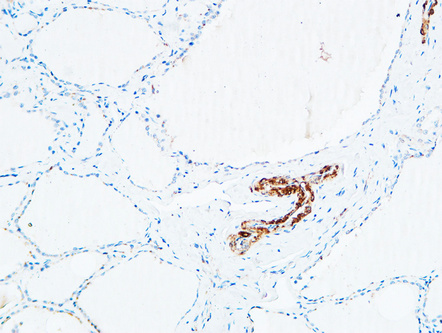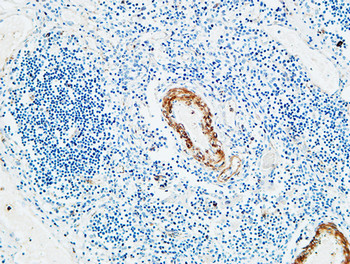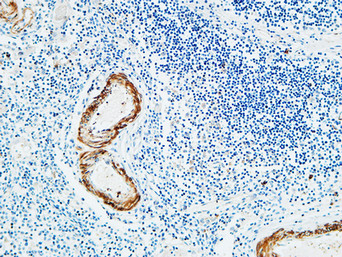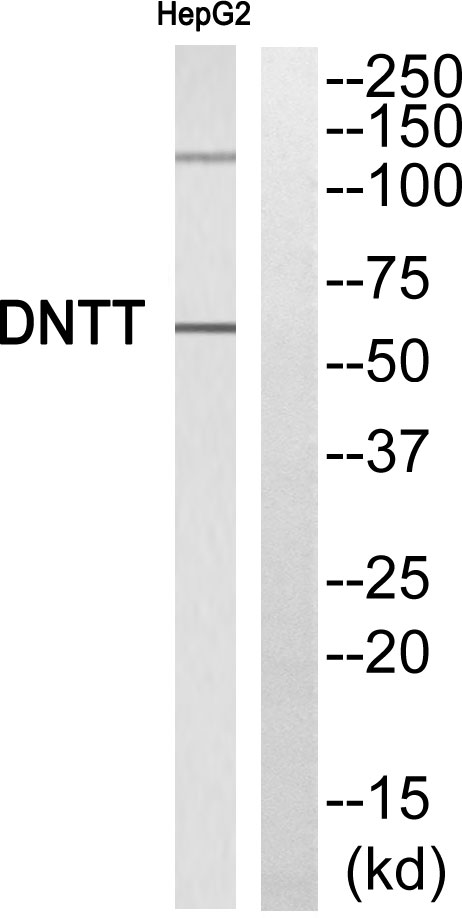TdT Polyclonal Antibody
- Catalog No.:YT4594
- Applications:WB;IHC;IF;ELISA
- Reactivity:Human;Mouse
- Target:
- TdT
- Fields:
- >>Non-homologous end-joining;>>Hematopoietic cell lineage
- Gene Name:
- DNTT
- Protein Name:
- DNA nucleotidylexotransferase
- Human Gene Id:
- 1791
- Human Swiss Prot No:
- P04053
- Mouse Swiss Prot No:
- P09838
- Immunogen:
- The antiserum was produced against synthesized peptide derived from human DNTT. AA range:381-430
- Specificity:
- TdT Polyclonal Antibody detects endogenous levels of TdT protein.
- Formulation:
- Liquid in PBS containing 50% glycerol, 0.5% BSA and 0.02% sodium azide.
- Source:
- Polyclonal, Rabbit,IgG
- Dilution:
- IHC: 100-300.WB 1:500 - 1:2000. ELISA: 1:40000.. IF 1:50-200
- Purification:
- The antibody was affinity-purified from rabbit antiserum by affinity-chromatography using epitope-specific immunogen.
- Concentration:
- 1 mg/ml
- Storage Stability:
- -15°C to -25°C/1 year(Do not lower than -25°C)
- Other Name:
- DNTT;TDT;DNA nucleotidylexotransferase;Terminal addition enzyme;Terminal deoxynucleotidyltransferase;Terminal transferase
- Observed Band(KD):
- 60kD
- Background:
- This gene is a member of the DNA polymerase type-X family and encodes a template-independent DNA polymerase that catalyzes the addition of deoxynucleotides to the 3'-hydroxyl terminus of oligonucleotide primers. In vivo, the encoded protein is expressed in a restricted population of normal and malignant pre-B and pre-T lymphocytes during early differentiation, where it generates antigen receptor diversity by synthesizing non-germ line elements (N-regions) at the junctions of rearranged Ig heavy chain and T cell receptor gene segments. Alternatively spliced transcript variants encoding different isoforms of this gene have been described. [provided by RefSeq, Jul 2008],
- Function:
- catalytic activity:Deoxynucleoside triphosphate + DNA(n) = diphosphate + DNA(n+1).,cofactor:Magnesium.,disease:Very high levels of enzyme activity have been detected in certain acute leukemic cells.,function:Template-independent DNA polymerase which catalyzes the random addition of deoxynucleoside 5'-triphosphate to the 3'-end of a DNA initiator. One of the in vivo functions of this enzyme is the addition of nucleotides at the junction (N region) of rearranged Ig heavy chain and T-cell receptor gene segments during the maturation of B- and T-cells.,similarity:Belongs to the DNA polymerase type-X family.,similarity:Contains 1 BRCT domain.,subunit:Interacts with PRP19 and DNTTIP1. Forms a ternary complex with DNTTIP2 and core histone. Released from this complex by PCNA.,
- Subcellular Location:
- Nucleus .
- Expression:
- Testis,Thymus,
- June 19-2018
- WESTERN IMMUNOBLOTTING PROTOCOL
- June 19-2018
- IMMUNOHISTOCHEMISTRY-PARAFFIN PROTOCOL
- June 19-2018
- IMMUNOFLUORESCENCE PROTOCOL
- September 08-2020
- FLOW-CYTOMEYRT-PROTOCOL
- May 20-2022
- Cell-Based ELISA│解您多样本WB检测之困扰
- July 13-2018
- CELL-BASED-ELISA-PROTOCOL-FOR-ACETYL-PROTEIN
- July 13-2018
- CELL-BASED-ELISA-PROTOCOL-FOR-PHOSPHO-PROTEIN
- July 13-2018
- Antibody-FAQs
- Products Images

- Western Blot analysis of HepG2 cells using TdT Polyclonal Antibody cells nucleus extracted by Minute TM Cytoplasmic and Nuclear Fractionation kit (SC-003,Inventbiotech,MN,USA).

- Immunohistochemical analysis of paraffin-embedded Human Thyroid. 1, Antibody was diluted at 1:200(4° overnight). 2, High-pressure and temperature EDTA, pH8.0 was used for antigen retrieval. 3,Secondary antibody was diluted at 1:200(room temperature, 30min).

- Immunohistochemical analysis of paraffin-embedded Human thymus. 1, Antibody was diluted at 1:200(4° overnight). 2, High-pressure and temperature EDTA, pH8.0 was used for antigen retrieval. 3,Secondary antibody was diluted at 1:200(room temperature, 30min).

- Immunohistochemical analysis of paraffin-embedded Human thymus. 1, Antibody was diluted at 1:200(4° overnight). 2, High-pressure and temperature EDTA, pH8.0 was used for antigen retrieval. 3,Secondary antibody was diluted at 1:200(room temperature, 30min).

- Western blot analysis of DNTT Antibody. The lane on the right is blocked with the DNTT peptide.



